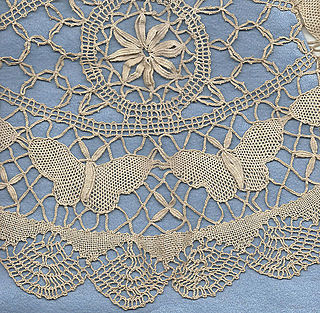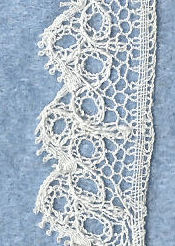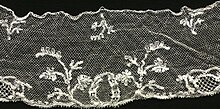Gimp or GIMP may refer to:

Bobbin lace is a lace textile made by braiding and twisting lengths of thread, which are wound on bobbins to manage them. As the work progresses, the weaving is held in place with pins set in a lace pillow, the placement of the pins usually determined by a pattern or pricking pinned on the pillow.

Chantilly lace is a handmade bobbin lace named after the city of Chantilly, France, in a tradition dating from the 17th century. The famous silk laces were introduced in the 18th century. Chantilly lace, was also produced in the 19th century but this one was actually made not in Chantilly area but in the French Norman town Bayeux and in Geraardsbergen, now in Belgium.

Guipure lace is a type of bobbin lace. It connects the motifs with bars or plaits rather than net or mesh.

Tønder lace is a point-ground type of handmade bobbin lace identified with the Tønder region of Denmark since about 1850, although lace of many types has been made there since as early as 1650. The term is also used more broadly, to refer to any bobbin lace made in Denmark.

Hollie point is an English needle lace noted for its use in baby clothes, particularly in the 18th century. It is also known as Holy point, because it was originally used in liturgical laces. The Puritans were the first to make common usage of Hollie point beginning in the reign of James I.

Point de Gaze is a needle lace from Belgium named for the gauze-like appearance of the mesh ground. It was made from the early to mid 1800s to sometime between 1914 and the 1930s.

Antwerp lace is a bobbin lace distinguished by stylized flower pot motifs on a six point star ground. It originated in Antwerp, where in the 17th century an estimated 50% of the population of Antwerp was involved in lace making. Antwerp lace is also known, from its familiar repeated motif, as Pot Lace— in Dutch Pottenkant or Potten Kant. It is sometimes said that the flowers were a depiction of the Annunciation lilies; however, the flowers were not limited to lilies.

Trim or trimming in clothing and home decorating is applied ornament, such as gimp, passementerie, ribbon, ruffles, or, as a verb, to apply such ornament.

Passementerie or passementarie is the art of making elaborate trimmings or edgings of applied braid, gold or silver cord, embroidery, colored silk, or beads for clothing or furnishings.

Galloon is a heavily-decorated woven or braided trim, typically made of, or featuring, gold or silver thread, which may be woven or embroidered. Galloon trim is used in the trim of military and police uniforms, ecclesiastical dress, and as trim on textiles, drapery, and upholstery. Galloon trim may also come in the form of lace, and is typically wide.

Valenciennes lace is a type of bobbin lace which originated in Valenciennes, in the Nord département of France, and flourished from about 1705 to 1780. Later production moved to Belgium, in and around Ypres. The industry continued onto the 19th century on a diminished scale. By the 19th century Valenciennes lace could be made by machine.

Mechlin lace or Point de Malines is an old bobbin lace, one of the best known Flemish laces, originally produced in Mechelen. Worn primarily during summer, it is fine, transparent, and looks best when worn over another color. Used for women's clothing, it was popular until the first decade of the 20th century. It was made in Mechelen, Antwerp, Lier and Turnhout. It was used for coiffures de nuit, garnitures de corset, ruffles and cravats.

Brussels lace is a type of pillow lace that originated in and around Brussels. The term "Brussels lace" has been broadly used for any lace from Brussels; however, strictly interpreted, the term refers to bobbin lace, in which the pattern is made first, and the ground, or réseau added, also using bobbin lace. Brussels lace is not to be confused with Brussels point, which is a type of needle lace, though sometimes also called "Brussels lace".

Blonde lace is a continuous bobbin lace from France that is made of silk. The term blonde refers to the natural color of the silk thread. Originally this lace was made with the natural-colored silk, and later in black. Most blonde lace was also made in black. It was made in the 18th and 19th centuries. The pattern, which is generally of flowers, is made with a soft silk thread, thicker than the thread used for the ground. This causes a big contrast between the flowers and the ground. It uses the same stitches as Chantilly lace and Lille lace, and is similarly made in strips 5 in (13 cm) wide and invisibly joined. Blonde lace is not as good as Chantilly lace though, as the ground is not as firm, nor is the pattern as regular.

Bucks point is a bobbin lace from the South East of England. "Bucks" is short for Buckinghamshire, which was the main centre of production. The lace was also made in the nearby counties of Bedfordshire and Northamptonshire. Bucks point is very similar to the French Lille lace, and thus is often called English Lille. It is also similar to Mechlin lace and Chantilly lace.

Torchon lace is a bobbin lace that was made all over Europe. It is continuous, with the pattern made at the same time as the ground. Typical basic stitches include whole stitch, half stitch, and twists, and common motifs include spiders and fans. Torchon lace was notable historically for being coarse and strong, as well as consisting of simple geometric patterns and straight lines. It did not use representational designs, for the most part.

Binche lace is a type of bobbin lace that originated in the town of Binche, Belgium. It is continuous, meaning it is made all at once, in one piece. It is generally made in strips 2 inches (5 cm) wide. Though typically it has no cordonnet outlining the design against the ground, occasional pieces are made with a very fine one, about the same thickness as the thread used in the pattern. The pattern in Binche lace is very detailed, with animal scenes and figures.

Battenberg lace is a type of tape lace. It is of American origin, designed and first made by Sara Hadley of New York. This American lace was named either in honor of the wedding of Princess Beatrice, Queen Victoria's youngest daughter, to Prince Henry of Battenberg, or from [sic] the widowed Princess Beatrice. It is made using bobbins and needles, or just needles alone.The original Battenberg lace used just one stitich: buttonhole picot. Other stitches that were later used include flat wheel and rings or "buttons".

The Barmen lace machine makes perfect copies of torchon lace and the simpler hand-made bobbin lace. Its bobbins imitate the movements of the bobbins of the hand-made lace maker.
























